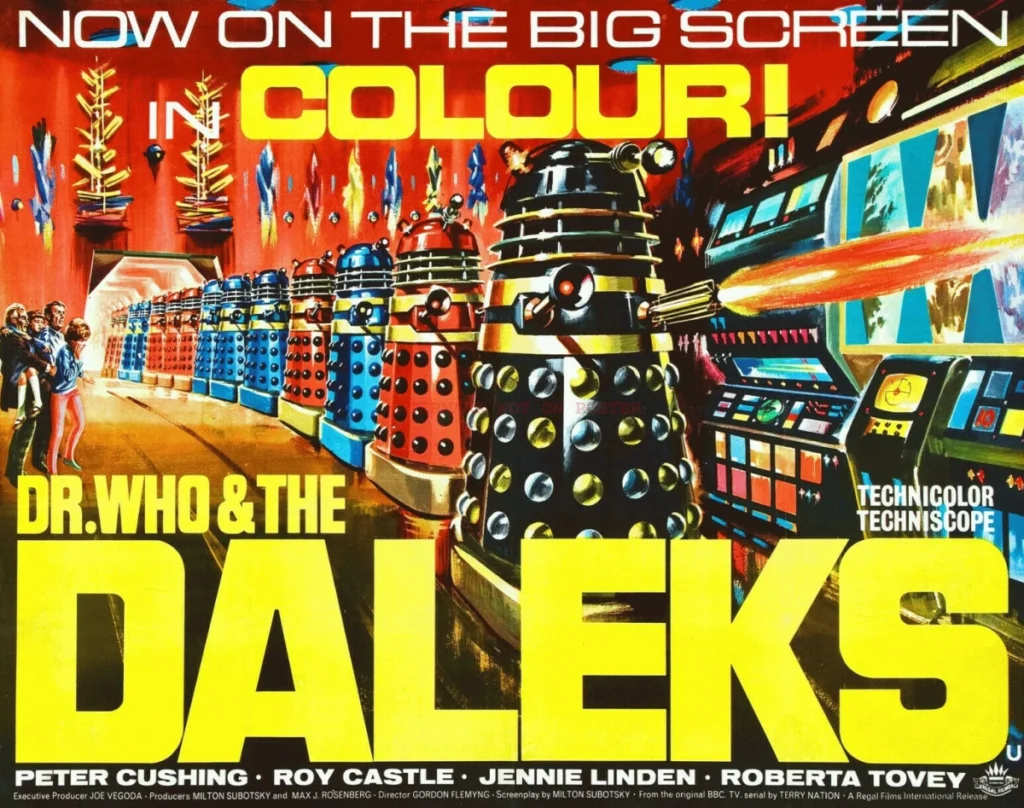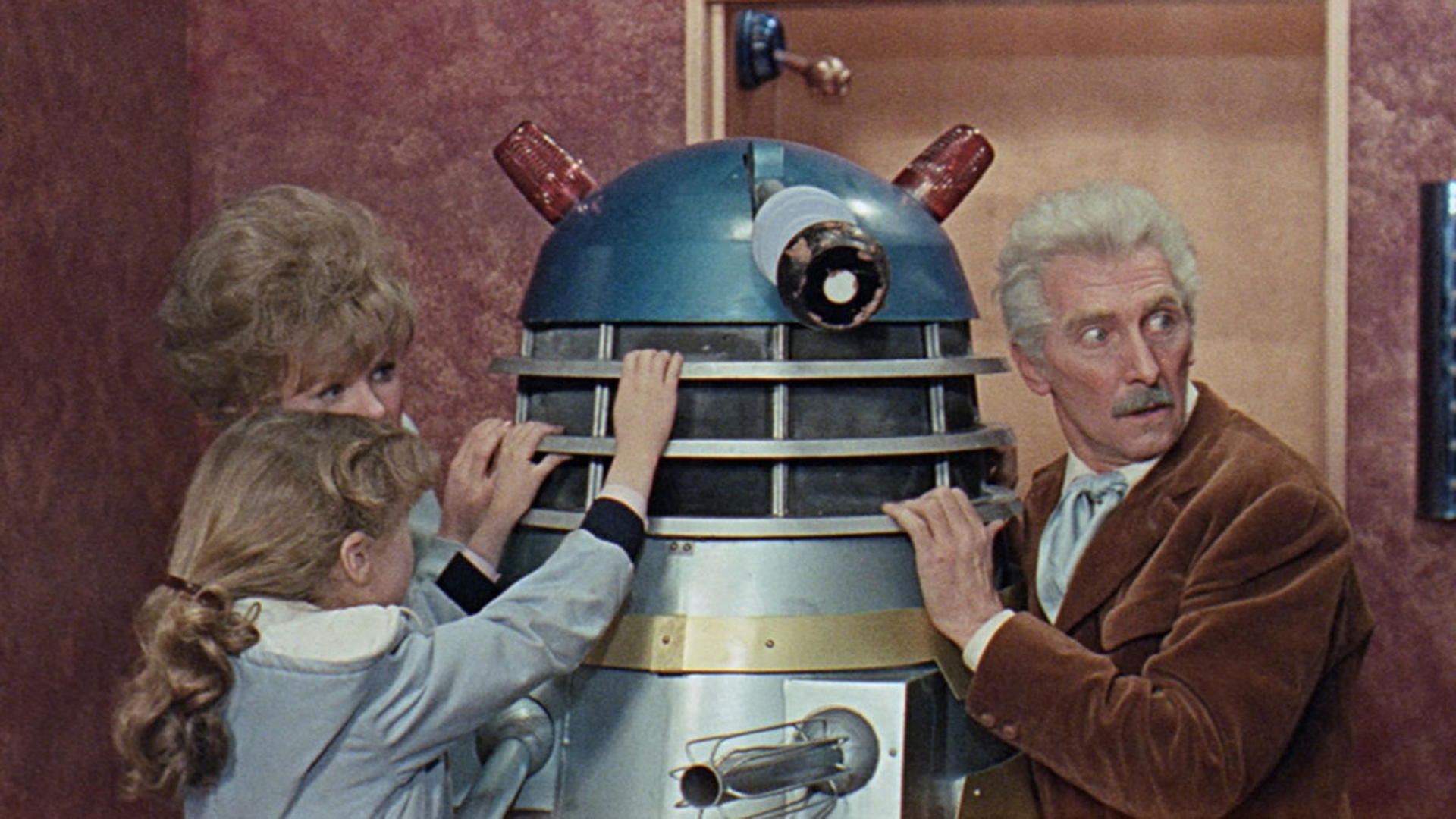“Doctor Who and the Daleks” is a 1965 British science fiction film directed by Gordon Flemyng and produced by Milton Subotsky, based on the long-running BBC television series Doctor Who. However, rather than being a direct continuation or spin-off of the TV series, it is actually a loose adaptation of the second Doctor Who story ever broadcast, “The Daleks” (1963–1964). Featuring Peter Cushing as a human version of the Doctor, the film marks the first cinematic portrayal of Doctor Who, and introduced the iconic Daleks to a broader audience.
A Different Kind of Doctor
One of the most notable aspects of Doctor Who and the Daleks is its divergence from the established continuity of the TV show. While the original series featured William Hartnell as a mysterious alien Time Lord from the planet Gallifrey, the film reimagines the Doctor as a human inventor named Dr. Who. Played by Peter Cushing with warmth and gentle eccentricity, this version of the Doctor is a kindly grandfather figure rather than the enigmatic and sometimes abrasive time traveler of the TV series.
In this cinematic version, Dr. Who builds a time machine called TARDIS (Time and Relative Dimension in Space) in his own backyard. He shares his home with his granddaughters, Susan (played by Roberta Tovey) and Barbara (Jennie Linden), the latter bringing along her clumsy boyfriend Ian (Roy Castle). The film kicks off when Ian accidentally activates the TARDIS, transporting the group to the distant, irradiated planet Skaro—a world locked in a nuclear deadlock between two species: the peaceful humanoid Thals and the genocidal, machine-encased Daleks.
From Skaro with Doom
Skaro is depicted as a haunting, alien world with a surreal, almost theatrical set design. Though limited by the special effects and budgets of the mid-60s, the film’s visual aesthetic was colorful and vivid—offering a striking contrast to the black-and-white television serial it was based on. The Dalek city, with its sliding doors, strange architecture, and illuminated control rooms, helped create an immersive and otherworldly atmosphere.
The Daleks themselves were a major draw. Designed by Raymond Cusick and now in full Technicolor, the film’s Daleks retained their menacing, pepper-pot form but gained more vivid color schemes to differentiate ranks and roles. These mechanical monstrosities, with their robotic voices and deadly “death ray” arms, captured the public imagination and further entrenched their role as the Doctor’s most iconic adversaries.
Unlike the television version of “The Daleks,” which unfolded over seven episodes and gradually built tension and character development, the film compresses the story into a brisk 82 minutes. This tighter runtime necessitated several changes, including simplified character arcs and more action-oriented storytelling.
A Tale of Conflict and Coexistence
At its heart, Doctor Who and the Daleks retains the basic thematic structure of the original serial: a classic battle between good and evil, with a deeper message about the dangers of hatred, war, and xenophobia. The Daleks are portrayed as the ultimate fascists—emotionless, intolerant, and driven by a desire for racial purity. Their fear of contamination by the outside world, and their willingness to annihilate the Thals to maintain their superiority, serves as a potent allegory for the totalitarian regimes of the 20th century.
In contrast, the Thals are peaceful and agrarian, initially unwilling to fight back. Their moral dilemma—whether to sacrifice their pacifism to confront evil—is one of the story’s central tensions. Eventually, prompted by the Doctor and his companions, the Thals rise to defend their world, and the Daleks are seemingly destroyed when their own power supply is sabotaged.
While simplified for younger audiences, these themes remain impactful, reflecting Cold War anxieties and timeless questions about morality, resistance, and the cost of peace.
Casting and Characters
Peter Cushing’s portrayal of Dr. Who is markedly different from any canonical Doctor, yet he brings his own charm to the role. His character is more whimsical and fatherly, lacking the mystery and alien detachment of the TV Doctor. While some fans regard the film’s deviations as heretical, Cushing’s portrayal has earned affection over the years, particularly from those who encountered the films before the series.
Roberta Tovey shines as young Susan, offering a smart and resourceful counterpoint to Roy Castle’s bumbling Ian. The film’s comedic moments—mostly courtesy of Castle—add levity and appeal to children, though they can sometimes undercut the tension for adult viewers.
Behind the Scenes and Production Notes
Produced by Amicus Productions, Doctor Who and the Daleks was aimed squarely at a family audience, capitalizing on the Dalekmania sweeping the UK in the early 1960s. The Daleks had become a cultural phenomenon, with toys, merchandise, and media spin-offs fueling their popularity.
The film was shot in Technicolor at Shepperton Studios, with sets and props designed for a more cinematic look than the BBC’s low-budget television sets. The soundtrack by Malcolm Lockyer complements the film’s atmosphere, adding drama and whimsy where appropriate.
Although the film was relatively successful at the box office, especially with younger viewers, critical reception was mixed. Purists criticized its departure from the source material, while others praised its accessibility and entertaining pace.
Legacy and Influence
Despite not being considered canon in the Doctor Who universe, Doctor Who and the Daleks holds an important place in the franchise’s history. It was the first attempt to bring the Doctor to the big screen, and for many international audiences—particularly in the U.S.—it was their first exposure to the character and his world.
The film was followed by a sequel, Daleks’ Invasion Earth: 2150 A.D. (1966), again starring Peter Cushing. The sequel, based on the television story “The Dalek Invasion of Earth,” featured a darker tone and bigger budget, though it too remained outside the TV continuity.
Both films eventually achieved cult status, enjoying re-releases, remasters, and home media editions. In 2022, both films were restored in 4K UHD and released in a lavish collector’s set, sparking renewed interest and appreciation among fans both old and new.
A Curiosity, Not a Canon
Ultimately, Doctor Who and the Daleks occupies a strange but charming corner of the Whoniverse. It is neither canonical nor entirely faithful to its source, yet it preserves the spirit of adventure, curiosity, and moral reflection that defines the best of Doctor Who. With vibrant visuals, a memorable performance by Peter Cushing, and the enduring terror of the Daleks, the film remains a nostalgic gem—an alternate timeline of Doctor Who that continues to entertain generations.
Whether viewed as a time capsule of 1960s sci-fi or as a delightful curiosity for fans, Doctor Who and the Daleks is a fascinating example of how pop culture icons evolve, adapt, and find new life in unexpected forms.


